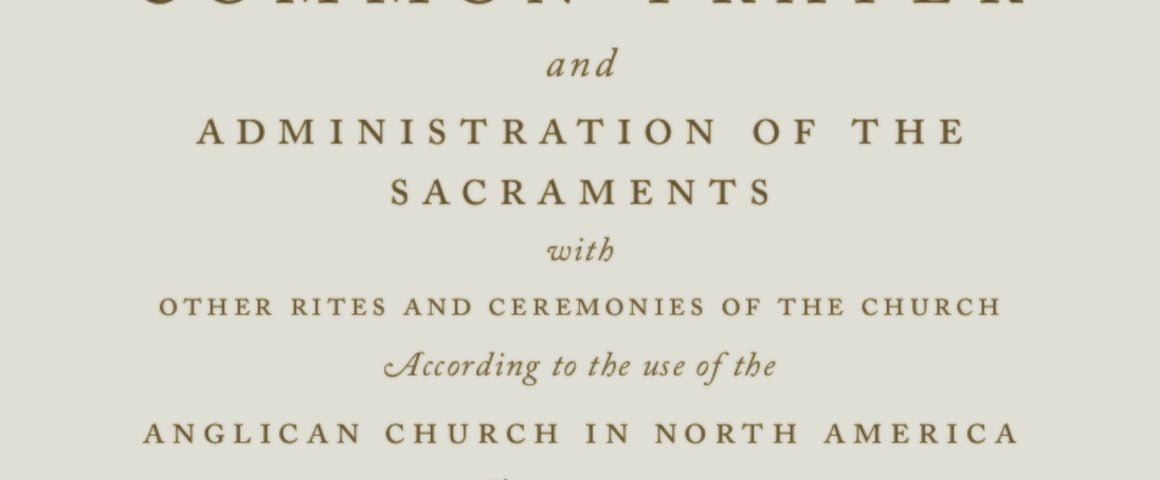Last month, Gerald McDermott interviewed the Rev. Ben Jefferies, the secretary of the Liturgy and Common Worship Task Force, regarding the 2019 Book of Common Prayer. In the wake of this interview, a massive debate has raged across the Anglican side of social media about whether or not, as Fr. Jefferies has claimed, the 2019 BCP takes the 1662 English Prayer Book as normative.
At a first glance, and even at a more in depth look, the 2019 Prayer Book bears many hallmarks of what can be called the “modern prayer book tradition,” a group comprising such notorious figures as the 1979 American Prayer Book, Common Worship from the Church of England, and the Canadian Book of Alternative Services. The 1662 BCP would find no home here. In this crowd is contained eucharistic sacrifice, prayers for the dead, “Choose-your-own-adventure” liturgy, and versions of Hippolytus. After using the 2019 Prayer Book in my personal devotions for several months now, however, several subtle differences have begun to appear.
I will address first the elephant in the room – the proliferation of options. To be frank, Fr. Jefferies must have poorly phrased his statement that the 2019 Prayer Book uses more options than any previous prayer book, because that simply isn’t true. In the following numbers, I am not going to count the Penitential Order found in the American books, nor the Offertory sentences, only the main liturgies themselves. The 1979 American Prayer Book has 8 Eucharistic Prayers (I, II, A, B, C, D, 1, 2), 6 forms of the Prayers of the People, 3 forms of Confession, 8 Concluding Collects, 3 “Kyries” in the opening rite (Kyrie, Trisagion, or Decalogue), 2 Creeds, 2 Lord’s Prayers, 1 Fraction, 1 Invitation, 3 Post-Communions, and 4 Dismissals. Multiply all the combinations together, and you have 82,944 possible options. The 2019 American Prayer Book has 3 Eucharistic Prayers (AST, RAT, and 1662), 2 forms of the Prayers of the People, 2 forms of Confession, 1 Concluding Collect, 3 “Kyries” in the opening rite (Kyrie, Trisagion, or Decalogue), 1 Creed, 2 Lord’s Prayers, 2 Fractions, 2 Invitations, 3 Post-Communions (2 Standard Post-Communions, and the Oblation if 1662), and 4 Dismissals. Multiply all the combinations together, and you have 3,456 options. The 1662 English Prayer Book has 1 Eucharistic Prayer, 1 form of the Prayers of the People, 1 form of Confession, 6 Concluding Collects, 2 Prayers for the Monarch, 1 Decalogue, 1 Creed, 1 Lord’s Prayer, and 2 Post-Communions. Multiply all the combinations together and you have 24 options. The Anglican world has opened Pandora’s Box. Even during the era of the 1928 Prayer Book (which has 96 options), the use of missals and other authorized, non Prayer Book liturgies, created an abundance of choices for the Celebrant or the Parish when preparing for worship. It would be a nigh-impossible feat to reduce the number of options so heavily. For the average worshipper, most of these options don’t matter. Concluding Collects, the Fraction, the Invitation, and the Dismissal do not change the response from the congregant. It is why the 1662 allowed options here – the response is Amen regardless of the Collect for the Queen, so why not have two? The number of options is far reduced from the absurd 8 Eucharistic Prayers of the 1979 rite, to two common Eucharistic prayers.
Another great concern is the shape of the liturgy. The 1979 shape is maintained in the 2019 Book – Prayer for the Church, Confession, Offertory, Consecration, Oblation, Communion. In fact, it looks rather familiar to those of us who have grown up on the 1979 Rite 1 liturgy. However, while the shape reflects the 1979, the content is most definitely that of 1662. While the footnote suggests otherwise, the epiclesis used is actually very much in line with the theology of the 1662, and its placement in the Consecration reflects that of 1662. The only phrase lacking in the 1662 Prayer is the direct invocation to bless and sanctify, with Word and Holy Spirit. Otherwise, it asks that we receiving the gifts and creatures of bread and wine may be partakers of the Body and Blood. This is, if anything, a restoration of the 1662 theology – asking that we receive the bread and wine and partake of the Body and Blood, even before the elements are truly consecrated. Scots insertions such as “rendering unto thee most hearty thanks for the innumerable benefits procured unto us by the same” and “which we now offer unto thee” have been excised. Three prayers were added to the Oblation portion of the prayer which are not present in the 1662 – a prayer offering the elements (which is necessary, since the elements were not offered at the Prayer for the Church Militant), for worthy reception (which makes a great deal of sense if one recites the Oblation prior to the Communion itself, and would not offend the theology of the 1662), and the prayer that we may be made one body with him, that he may dwell in us, and we in him. This prayer also, has its origin in the English rite of 1549 and does not conflict with a virtualist theology. Most of the changes made were to conform the shape to the theology of the 1662 without making it absurdly intrusive to the average parishioner. The Ministration of Communion even had its shape altered, chiefly to reflect the order of the 1549 Book if Confession were excised.
Prayer for the departed is also a crux of conflict in the new book. It is true that the 2019 Prayer Book relies far more heavily on prayer for the dead than the 1662 would, but the claim that the 1662 truly has no prayer for the dead is debatable. What kind of prayer for the dead, however, should be used is a conversation worth having. The 1662 Prayer Book contains this prayer in the Burial service:
“Almighty God, with whom do live the spirits of them that depart hence in the Lord, and with whom the souls of the faithful, after they are delivered from the burden of the flesh, are in joy and felicity: We give thee hearty thanks, for that it hath pleased thee to deliver this our brother out of the miseries of this sinful world; beseeching thee, that it may please thee, of thy gracious goodness, shortly to accomplish the number of thine elect, and to hasten thy kingdom; that we, with all those that are departed in the true faith of thy holy Name, may have our perfect consummation and bliss, both in body and soul, in thy eternal and everlasting glory; through Jesus Christ our Lord. Amen.”
The key phrase here, “that we, with all those &c., may have our perfect consummation and bliss,” highlights two elements of Anglican prayer for the departed that are important. Firstly, it is prayer for all those “departed in the true faith of thy holy Name” – the faithful departed. It is prayer for those Christians who, having run the race, have fallen asleep in the Lord. It is secondly prayer that those Christians should have “perfect consummation and bliss.” It does not suggest that they need forgiveness or absolution, but only that they may have a perfect consummation and bliss. The 2019 Prayer Book consistently does this – “departed this life in your faith and fear, that your will for them may be fulfilled”…“departed this life in the certain hope of the resurrection, in thanksgiving let us pray”…“Acknowledge, we humbly beseech you, a sheep of your own flock”…“receive him into the arms of your mercy, into the blessed rest of everlasting peace, and into the glorious company of the saints”…“the favor which you show to all your people”…“Grant that, increasing in knowledge and love of you,” et cetera. This is the not the “Romish doctrine” of purgatory that we pray for here, but rather that the faithful who have gone into God’s presence may grow closer to him. The same model is used over and over again – a model which reflects the theology of the English Prayer Book tradition.
The 2019 Prayer Book is, without a doubt, the closest that anyone can get in the aftermath of 1979 to a contemporary English Prayer Book-style liturgy. It is truly a book of compromise, forged over the last ten years by many capable and Godly individuals, but it is also a book of principles, which have been uniformly applied throughout the text. I have every confidence that this prayer book reflects the doctrine and practice of the 1662.







'The ACNA Prayerbook: Faithful to the 1662 BCP?' have 7 comments
July 7, 2019 @ 5:09 pm Bishop Joel Marcus Johnson
Is the new prayer book available online?
July 7, 2019 @ 6:32 pm Fr. Brench
This is one of the most concise treatments of prayer for the departed that I’ve read lately, thank you for spelling this out!
July 7, 2019 @ 7:16 pm Shane Copeland
You have made some strong statements here arguing for why some of the changes made make the BCP 2019 more like the 1662. To a certain extent that is true. But I would argue that the content and structure of the 2019 BCP “Holy Communion” Service is much more in line with the 1928 American BCP than the 1662. The simplicity and consistent theology of Cranmer’s rite (1552/1559/1662) is more muddled in the 1928 and the 2019.
Starting with the footnote in the 2019, it is not accurate. The whole paragraph, minus the phrase, “ we ask you to bless and sanctify, with your Word and Holy Spirit,” is in the 1662 (as you point out). But the addition of the Epiclesis does not make the 2019 somehow closer to the 1662. There is a reason why Cranmer left it out in 1552. He did not want people to be confused about the presence of Christ in the Sacrament. Asking for God to specifically bless and sanctify the bread and wine might imply a localized presence which the Reformers denied (I don’t think that an Epiclesis necessarily implies this, but “might”). This is why the Epiclesis lacking paragraph in the 1662 states, “that we receiving …bread and wine…may be partakers of the his most blessed body and blood.” The presence of Christ is in the partaking (His body being in Heaven…see the Black Rubric, especially the 1552).
Also, to suggest that adding a “necessary” Oblation is somehow more in line with the 1662 is to dismiss Cranmer and the English Reformers. He intentionally left out an “offering of the bread and wine.” The structure Cranmer’s Communion rite reflects the Gospel of God’s movement towards us in the giving of His Son. We don’t even bring the bread and wine, they are gifts of God’s creation to us, to be for us more than mere bread and wine as we eat in our hearts with faith and thanksgiving. There is only one thing we offer to God in the whole Holy Communion Service: our praise and thanksgiving (and our bodies and souls as connected to this). And this only happens after the Partaking of the Sacrament.
Even the Prayer of Humble Access’ position reflects the order of the 1928 and not the 1662 (which finishes with important “dwelling” language).
Finally, your interpretation of the burial prayer as being a “prayer for the dead” again ignores what Cranmer and the English Reformers believed. To apply hermeneutics, you are doing eisigesis and not exegesis to the text, reading a meaning into that the original authors did not have.
I agree that the BCP 2019 is a move back from the 1979 (and that is good), but the theology and structure of it is closer to the American 1928 much more than the 1662 regardless of any claims put forth. I find the effort to try and make this fit the 1662 BCP fails because in too many key areas, it departs from the 1662. The 2019 does allow an order to structure the Communion service along the lines of the 1662, but it still requires some careful editing.
January 15, 2020 @ 9:22 pm David Goforth
Mr. Copeland, you make a valid critique and I’ve come to the some of the same conclusions. I’ve read articles by other evangelicals making comparisons of their new prayer books to the theology of the 1662; same types of examples are shown. I wish that the ACNA rubric and Holy Communion prayer didn’t talk about offerings to God these gifts of bread and wine. In the OT, God required food offerings for their forgiveness. But in the NT, God instead offered us Jesus Christ. The 1662 was careful not to have language like that. This isn’t a toned down version of the sacrifice of the mass. The ACNA’s Renewed Ancient Text is almost identical to the TEC 1978 Rite 2. Both of which are not the same as the 1662 in terms of theology. Obviously there are lots of other Oxford Movement influences in other areas; but often it is more like wiggle room. I’d prefer the more reformed liturgy of the 1662 BCP, but in America, it is very unlikely to ever be used. ACNA overall I think is a very good experiment and seems to be very orthodox. I love the ACNA churches that I’ve worshipped in. Very grounded in the Bible.
July 8, 2019 @ 11:04 am Robert W. Hauer
Very thoughtful analysis/comparison and contrast of BCPs. Not being a theologian, canonical lawyer, or clergy I have no “expert qualifications” to judge BCP. I grew up with 1928, but by high school found it quite repetitious as to Sunday Lessons. The 1979 BCP was an improvement with more liturgical options, lectionary cycle, and parish participation in certain prayers. I find no fault with it, but then again I am not an expert. I like the 2019 as it is well organized and elevated the importance pf the 39 Articles. The errata pointed out by many will no doubt be fixed. The “better translation” of some responses, to me are not an issue, Times change as to dress, language and customs. The Bible and orthodoxy do not change however, and the 2019 yields nothing or compromises nothing in regards to radition and orthodoxy.
The 2019 BCP is a magnificent work. But it cannot in and of itself bring about what is sorely needed within ACNA: unity and civility. The FB pages of Anglican groups are filled with acrimony and intolerance. They reflect the theme so prevalent in American politics: “my way or the highway”. The ACNA Constitution does not fully satisfy all parties, but is flexible enough to accommodate all in regards to orthodoxy (IMHO). If Jesus were to appear today at any church, would we recognize him, and he recognize us?
I’ve said alot…..and nothing.
July 8, 2019 @ 10:02 pm From The North American Anglican: Jacob Hootman on the ACNA 2019 Book of Common Prayer | Prydain
[…] link to another perspective published therein – this one by Jacob Hootman. Its title is The ACNA Prayerbook: Faithful to the 1662 BCP? and it is worth reading along with the others. His […]
January 22, 2023 @ 7:05 pm Vince Hart
May I get help to understand, why did the 2019 change the 1662 Collect of the Day? For example, the third Sunday of Epiphany, they are two, completely different prayers, 2019 vs 1662.
_1662_ COLLECT OF THE DAY
The Third Sunday of Epiphany.
Almighty and everlasting God, mercifully look upon our infirmities, and in all our dangers and necessities stretch forth thy right hand to help and defend us, through Jesus Christ our Lord. Amen
_2019_ COLLECT OF THE DAY
The Third Sunday of Epiphany
Give us grace, O Lord, to answer readily the call of our Savior Jesus Christ and proclaim to all people the Good News of his salvation, that we and the whole world may perceive the glory of his marvelous works; who lives and reigns with you and the Holy Spirit, one God, for ever and ever. Amen.
What were the reasons and guiding principles to change these?
The reason I ask, is that I am interested in setting all of the collects to music, very similar to the work done in 1856, by Eliza Humphreys, as provided in this excellent web site,
https://metricalcollects.com/
and the time comment to do this for the 2019 Collectors wants learning on my part prior to undertaking the project. As a musician, I’m seeking sources to learn the history and texts of the collects, and their apparent changes over time.
Thank you in advance, for your time in replying.
Vince Hart
TX